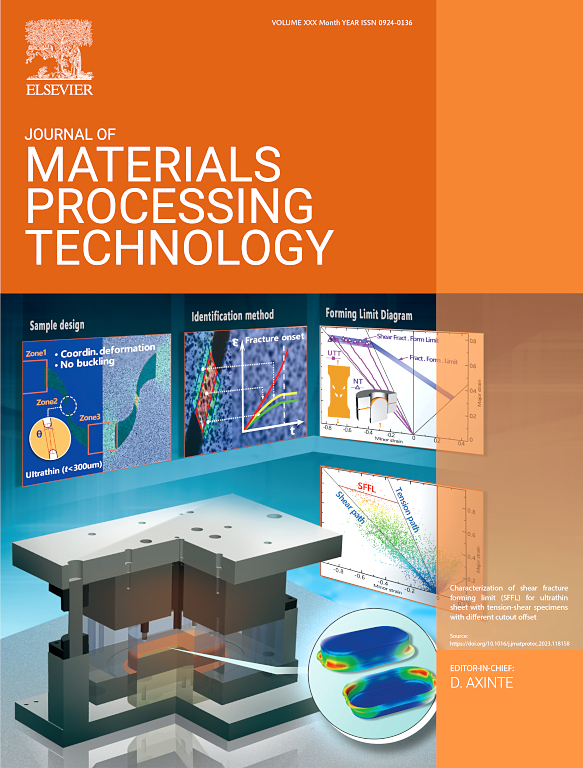通过新型螺纹铆钉实现CFRP/铝合金单面摩擦铆接接头的高强度和缺陷抑制
IF 7.5
2区 材料科学
Q1 ENGINEERING, INDUSTRIAL
Journal of Materials Processing Technology
Pub Date : 2025-09-05
DOI:10.1016/j.jmatprotec.2025.119054
引用次数: 0
摘要
在热固性碳纤维增强聚合物(CFRP)和铝合金的单面连接中,通常需要完全穿透工件,这可能会带来诸如钻穿堆叠层困难,接头损坏以及使用期间潜在的安全问题等挑战。本研究采用单面摩擦铆接(SSFR)工艺实现CFRP与铝合金的可靠连接,重点阐明了铆钉螺纹结构引起的接头微观组织特征和力学性能的内在差异。外螺纹铆钉减少了热量的产生,从而抑制了螺纹尖端的裂纹形成,扩大了无缺陷接头的工艺窗口。对内螺纹铆钉和外螺纹铆钉对接头力学性能的影响进行了系统的对比分析,并确定了关键的承载区域。在拉伸-剪切试验中,缺陷接头的裂纹使填充在螺纹中的铝合金不能有效地承受载荷。内螺纹接头的拉剪破坏模式主要表现为承重侧铝合金的塑性变形导致铆钉拔出,外螺纹接头的破坏模式主要表现为承重侧铝合金的撕裂导致铆钉拔出。无缺陷内螺纹接头的峰值拉剪力为7.0 kN,破坏位移为6.4 mm,分别比外螺纹接头高6.1 %和52.4 %。研究表明,通过优化铆钉螺纹设计和工艺参数,可以有效提高SSFR接头的成形质量和力学性能。本文章由计算机程序翻译,如有差异,请以英文原文为准。
Achieving high strength and defect suppression in CFRP/aluminum alloy single-sided friction riveted joints via novel threaded rivets
In the single-sided joining of thermoset carbon fiber-reinforced polymer (CFRP) and aluminum alloy, the complete penetration of the workpieces is typically required, which can lead to challenges such as difficulty in drilling through stacked layers, damage to the joint, and potential safety concerns during service. This study employs the single-sided friction riveting (SSFR) process to achieve a reliable joining between CFRP and aluminum alloy, with an emphasis on elucidating the intrinsic differences in microstructural characteristics and mechanical properties of the joints induced by threaded structures of rivets. The external threaded rivet reduces heat generation, thereby inhibiting crack formation at the thread tips and expanding the process window for defect-free joints. A systematic comparative analysis of internal and external threaded rivets on joint mechanical performance was conducted, and the key load-bearing areas were identified. Cracks in defective joints prevent the aluminum alloy filled in the thread from effectively bearing the load during tensile-shear tests. The tensile-shear failure mode of internal threaded joints was primarily characterized by the plastic deformation of the load-bearing side aluminum alloy, leading to rivet pull-out, while external threaded joints failed mainly due to tearing of the load-bearing side aluminum alloy, causing rivet pull-out. The peak tensile-shear force of defect-free internal threaded joints is 7.0 kN, with a failure displacement of 6.4 mm, which is 6.1 % and 52.4 % higher than that of external threaded joints, respectively. This work demonstrates that optimizing the rivet thread design and process parameters can effectively improve the forming quality and enhance the mechanical performance of SSFR joints.
求助全文
通过发布文献求助,成功后即可免费获取论文全文。
去求助
来源期刊

Journal of Materials Processing Technology
工程技术-材料科学:综合
CiteScore
12.60
自引率
4.80%
发文量
403
审稿时长
29 days
期刊介绍:
The Journal of Materials Processing Technology covers the processing techniques used in manufacturing components from metals and other materials. The journal aims to publish full research papers of original, significant and rigorous work and so to contribute to increased production efficiency and improved component performance.
Areas of interest to the journal include:
• Casting, forming and machining
• Additive processing and joining technologies
• The evolution of material properties under the specific conditions met in manufacturing processes
• Surface engineering when it relates specifically to a manufacturing process
• Design and behavior of equipment and tools.
 求助内容:
求助内容: 应助结果提醒方式:
应助结果提醒方式:


